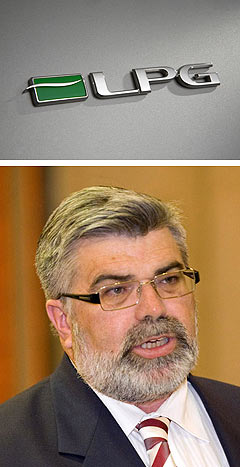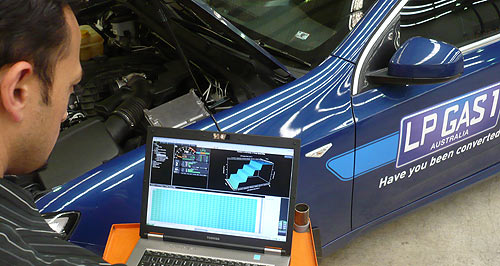Make / Model Search
News - General News - FuelsExports beckon for Aussie LPG breakthroughFine tuning: An engineer at Alternative Fuel Innovations tests liquid LPG injection systems in Melbourne. $3.5 million green car grant to fast-track Australian-first LPG injection system25 Jan 2011 PIONEERING Australian-developed liquid LPG injection technology that can be applied to both petrol and diesel engines to slash fuel costs and cut CO2 emissions will be fast-tracked to market with the help of a $3.5 million federal government Green Car Innovation Fund grant. The Liquajet technology, developed by Alternative Fuel Innovations (AFI) at its Rowville headquarters in Melbourne's east, can even be applied to the latest lean-burn direct-injection petrol engines now coming on to the market in Europe, with cheaper liquid LPG Autogas delivered via the petrol injector directly into the combustion chamber. In diesels, the system can substitute up to 50 per cent of the diesel fuel with LPG – which costs half as much as diesel per litre – for reduced exhaust emissions, more torque, less engine wear and large cost savings at both the pump and service garage. The company says testing shows its first-stage multi-point system for petrol cars can cut CO2 emissions by up to 15 per cent over petrol, compared with a 10 per cent reduction by traditional vapour LPG systems. The technology – the first such system to be developed wholly in Australia – is expected to open export markets in Europe and the United States, in many cases with companies that currently manufacture and export traditional gaseous LPG delivery systems to Australia. AFI is set to launch its own aftermarket multi-point port liquid injection system in Australia this year as a first step in the project, with systems developed for 15 Australian cars so far. Ultimately, the objective is to sell the system as original equipment to car-makers such as Ford, Holden and Toyota, as well as export markets. AFI, which has bought LPG tank-maker APA and two of Australia’s largest LPG equipment suppliers within the past three years to create what is claimed to be Australia’s first integrated automotive LPG supplier, already provides tanks and fuel delivery systems to Holden and Ford for their LPG models.  Left: Holden's LPG badge for Commodore. Below: Industry minister Kim Carr. Left: Holden's LPG badge for Commodore. Below: Industry minister Kim Carr.New single-fuel LPG models from Holden and Ford later this year will use AFI tanks and pumps – the so-called rear-end delivery system – although Ford’s Falcon will use an Orbital-supplied injection system with imported components, and Holden’s LPG Commodore will use its own gaseous multi-point injection system developed in-house with AFI input. The federal grant to AFI – the eighth handed out to local companies by innovation minister Kim Carr – brings to $296 million the total amount given to Australian manufacturers from the $1.3 billion fund since it was founded in July 2009 to encourage development of fuel-saving technologies and local manufacturing of environmentally friendly vehicles and components. The scheme – part of the federal government’s New Car Plan for a Greener Future – usually offers one government dollar for every three dollars committed by the recipient. On that basis, the AFI project is costing about $14 million. Announcing the grant, Senator Carr said the AFI project would facilitate a wider uptake of the more environmentally friendly LPG as a fuel option. While LPG users will benefit from new LPG injection technology, the federal government is also set to introduce a fuel excise on LPG from July, ramping it up by 2.5 cents a litre a year to 12.5 cents a litre in 2015. AFI engineering director Ben Lee told GoAuto that without the federal grant, the company’s liquid LPG technology would have taken up to 10 years to bring to market. He said the company – which previously imported its LPG injection components from Europe – now planned to introduce four forms of the locally developed LPI system within three years: multi-point port liquid LPG injection for standard petrol injection cars multi-point port liquid LPG injection for direct injection petrol cars direct-injection liquid LPG injection for lean-burn petrol engines and port liquid LPG injection fuel substitution system for diesel engines in trucks, cars and stationary applications such as pumps and generators. “We have been working with a lot of our overseas suppliers and they are all very much interested in utilising our technology around the world,” Mr Lee said. “We have also being in discussions with a lot of them in regards to distributorship of our product. So exports are very much on the cards for our liquid injection system.” Mr Lee said the company had addressed a problem associated with direct-injection petrol cars – such as Holden’s SIDI Commodore – when running on LPG. He said AFI’s system allowed the petrol injectors to squirt about five per cent of required fuel – the equivalent of running the engine at idle – through the injectors mounted in the cylinder head to keep them cool to prevent heat damage. “Our system substitutes a large ratio of fuel with liquid LPG, actually taking out 95 per cent of the pulse that would normally go to the petrol injector and applying that to the gas injector,” he said. “So essentially you are getting an idle quantity of petrol going through the petrol injector. By doing that you are keeping the petrol injector cool and assuring its ability to operate in future.” Mr Lee said the development of this system had come too late in the development cycle for Holden’s new mono-fuel LPG system, which Holden has confirmed to GoAuto will retain vapour injection when it goes into production later this year. “When we initiated the project with Holden, our Liquajet technology was not to the level that we could portray it to them,” he said. “The timing wasn’t quite right for us. So we are looking at obviously offering this system to Holden for a future model change, but that is down the track. We need to focus on their current release product now. “And the same goes with Ford also. We are looking at using our Liquajet system with all the OEMs (original equipment manufacturers).” Ford Australia and Holden Special Vehicles currently have liquid LPG injection supply contracts with AFI rival Orbital, which received $440,413 from the green car fund last year to help with the development of air-assisted petrol fuel direct injection systems for major Chinese car-maker Chang’an. Mr Lee said an advanced Liquajet system being developed by ACI was designed for the new-generation lean-burn petrol cars now being introduced by manufacturers such as Volkswagen. He said that system could switch the direct injection system from petrol to LPG, squirting either fuel directly into the cylinder via the same injector. “Lean burn engines can’t actually run with LPG injected into the port,” he said. “They need the fuel to be injected directly into the cylinder. “We therefore needed to develop the system so it would direct the liquid LPG directly into the same deformation in the piston top as the petrol injector, so you can get a localised stoichiometric mixture so you can get the same lean burn result as petrol.” The diesel system being developed by AFI injects LPG in parallel with diesel fuel, but uses a sophisticated computerised management system to cut the diesel supply to the engine by up to 50 per cent and substitute liquid LPG. Mr Lee said current ‘top-up’ systems available for diesel engines squirt LPG vapour into a central point in the inlet manifold, substituting around five per cent of fuel with LPG, mainly to help increase torque. “The system we have been developing monitors the signal that goes to the diesel injectors, intercepts that and substitutes a percentage of the pulse to our gas injectors,” he said. “By doing that, we have greater control over the fuelling compared with a traditional method, and we have higher substitution ratios. “So traditional systems have a maximum of up to 15 per cent substation ratio, but we believe we can push that boundary up to the 50 per cent mark.” Mr Lee said the diesel Liquajet system not only retained the increased torque of other systems but also reduced running costs by substituting more LPG and reducing engine wear through less contamination of engine oil.  Read more22nd of September 2010  HSV lures new breed of buyers with LPINew-generation LPG system expands HSV’s reach to buyers interested in fuel savings17th of August 2010  Labor to slash $200m from green car fundGillard camp follows Liberals in promising to cut from Green Car Innovation Fund |
Click to shareGeneral News articlesResearch General News Motor industry news |











Facebook Twitter Instagram